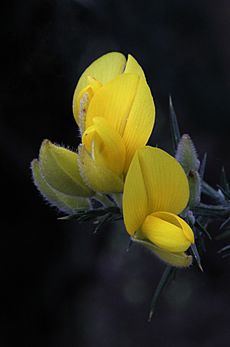Ulex facts for kids
Quick facts for kids Ulex |
|
|---|---|
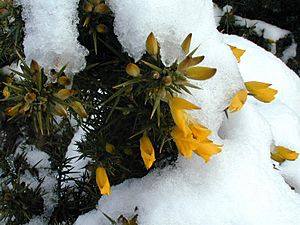 |
|
| Ulex europaeus | |
| Scientific classification |
|
| Kingdom: | Plantae |
| Clade: | Tracheophytes |
| Clade: | Angiosperms |
| Clade: | Eudicots |
| Clade: | Rosids |
| Order: | Fabales |
| Family: | Fabaceae |
| Tribe: | Genisteae |
| Genus: | Ulex L. |
| Species | |
|
11–58; see text |
|
| Synonyms | |
|
|
Gorse (also called furze or whin) is a type of flowering plant. It belongs to the pea family, Fabaceae. There are about 20 different kinds, or species, of gorse. They are evergreen shrubs, meaning they stay green all year. Gorse plants are very thorny!
Most gorse species grow naturally in western Europe and northwest Africa, especially in Spain and Portugal. Gorse is similar to broom plants. Like brooms, gorse has green stems and tiny leaves. It is also good at growing in dry places.
What makes gorse special is how thorny it is. Its shoots have changed into branched thorns that are about 1 to 4 centimeters (0.4 to 1.6 inches) long. These thorns do most of the photosynthesis for the plant. Young gorse plants have leaves with three parts, but older plants have leaves that are just small scales or spines. All gorse species have bright yellow flowers. Some types of gorse flower for a very long time.
Contents
Types of Gorse
The most different kinds of gorse are found in Spain and Portugal. Most species only grow in small areas. The most common type is called common gorse (Ulex europaeus). This is the only type that grows naturally in much of western Europe. It likes sunny spots and dry, sandy soils.
Common gorse is also the tallest type, growing up to 2 to 3 meters (6.5 to 10 feet) high. Other types, like western gorse (Ulex gallii), are usually much smaller, only about 20 to 40 centimeters (8 to 16 inches) tall. Western gorse often grows in windy Atlantic coastal areas and on mountains. In eastern Great Britain, dwarf furze (Ulex minor) replaces western gorse. Dwarf furze only grows about 30 centimeters (12 inches) tall. It is common in sandy lowland heathland.
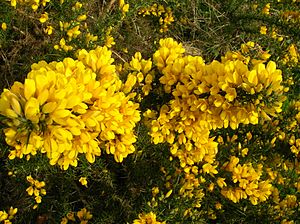
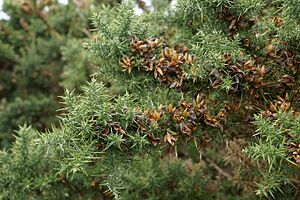
Common gorse flowers a little in late autumn and through winter. It flowers most strongly in spring. Western gorse and dwarf furze flower in late summer (August–September in Ireland and Great Britain). Because different types flower at different times, you can almost always find some gorse in bloom. This led to the old saying: "When gorse is out of blossom, kissing's out of fashion." Gorse flowers have a unique coconut smell. Some people can smell it very strongly, while others can barely smell it at all.
Main Gorse Species
Here are some of the main species of gorse:
- Ulex argenteus
- Ulex australis
- Ulex baeticus
- Ulex borgiae
- Ulex canescens
- Ulex cantabricus
- Ulex densus
- Ulex erinaceus
- Ulex eriocladus
- Ulex europaeus—common gorse
- Ulex gallii—western gorse or western furze
- Ulex jussiaei
- Ulex micranthus
- Ulex minor—dwarf furze or dwarf gorse
- Ulex parviflorus
Gorse and Nature
Gorse is very good at growing back after fires. It is highly flammable, meaning it catches fire easily. Its seed pods often open up when there's a fire, which helps new plants grow quickly. The burnt stumps can also sprout new growth from their roots. If there are no fires, taller trees might shade out gorse. Gorse usually burns every 5 to 20 years.
Gorse can grow well in poor conditions, even during droughts. It is sometimes found on very rocky soils where other plants cannot survive. It is also used to fix land that has been damaged, like old mine sites. Gorse helps other plants grow there because it can add nitrogen to the soil. This process is called nitrogen fixation.
Gorse is important for wildlife. Its dense, thorny branches provide great cover for bird nests. In Britain, France, and Ireland, it is known for helping birds like Dartford warblers and European stonechats. The whinchat bird is even named after gorse because it lives so closely with the plant. The flowers are sometimes eaten by the caterpillars of the double-striped pug moth. The caterpillars of the case-bearer moth Coleophora albicosta eat only gorse. The dry wood of dead gorse stems is food for the caterpillars of the concealer moth Batia lambdella.
Gorse as an Invasive Plant
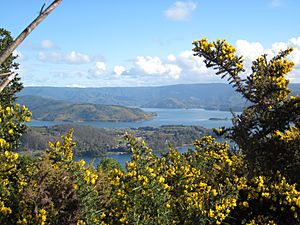
In many parts of North America (like California and Oregon), South America, Australia, New Zealand, and Hawaii, common gorse has become an invasive species. This means it was brought there by people, but it spread too much and harmed the local plants and animals. It is very hard to get rid of gorse once it spreads. Common gorse is also an invasive species in the mountain grasslands of Horton Plains National Park in Sri Lanka.
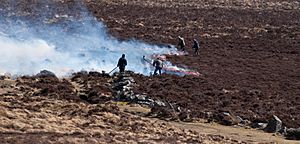
Managing Gorse
Gorse can easily take over an area if conditions are right. If people don't want gorse to grow everywhere, they need to control it. Gorse patches are often managed by regularly burning them or cutting them back. This allows them to regrow from their roots or from seeds. Very thick areas of gorse might even be cleared with bulldozers.
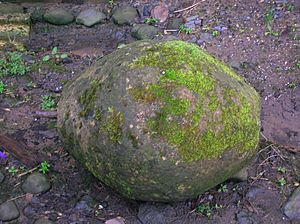
Uses of Gorse
Food and Animal Feed
Gorse flowers can be eaten. You can use them in salads or tea, or even to make a type of fruit wine.
Gorse is also high in protein, so it can be used as food for farm animals, especially in winter when other green plants are not available. In the past, farmers would crush gorse with mallets or grind it in mills to make it soft enough for cattle to eat. It was also chopped finely and mixed with straw. Some animals, like wild ponies, eat gorse as forage, especially in winter. Ponies might also eat the thinner stems of gorse after a fire.
Fuel
Gorse bushes are very flammable. In many places, bundles of gorse were used to heat traditional bread ovens. On the island of Guernsey, many old farms had "furze brakes." This is where they would cut, dry, and store gorse and bracken (another plant) to use as fuel. Farmhouses even had special ovens built just for burning furze.
Wood
Gorse wood has been used to make small items. It is safe to use for things like cutlery because it is non-toxic. Even though it is strong, it is not used for building because the plants are too small, and the wood can warp. Gorse is good for garden decorations because it can handle different weather and does not rot easily.
Alternative Medicine
Gorse is one of the 38 plants used to make Bach flower remedies. This is a type of alternative medicine.
Gorse as a Symbol
The furze flower is a symbol for the Sinclair and MacLennan clans in Scotland. The flower, called chorima in the Galician language, is the national flower of Galicia in northwest Spain. Gorse is also a symbol of Brittany and is becoming popular again in Cornwall, especially on St Piran's Day.
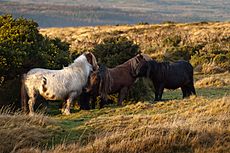
In Popular Culture
Because gorse catches fire quickly and burns out fast, it became a symbol for things that start strongly but don't last. For example, in his book Sir Nigel, Arthur Conan Doyle wrote that some people "flare up like a furzebush in the flames." This means they get very excited quickly but then calm down.
In many parts of Britain, especially Devon and Cornwall, where gorse grows a lot on the moors, people have a traditional saying: "kissing's out of fashion when the gorse is out of blossom." This is a joke because common gorse is thought to be always in bloom. Gorse sprigs were also a traditional gift between young lovers on May Day in this region, which is when the flowers are at their best.
See also
 In Spanish: Tojo para niños
In Spanish: Tojo para niños


